[one_half padding=”0 0 0 0px”]
Ruger Bearcat
[/one_half]
[one_half_last padding=”0 0 0 0px”]
[/one_half_last]
Here’s your firearm’s philosophy question-of-the-day: Is the Ruger Vaquero a big Bearcat, or is the Bearcat a small Vaquero? I can’t decide.
The origins of the Bearcat are nebulous, at best. The gun has come and gone from Ruger’s line-up. It is clearly based on the historical single actions that dominate wild west mythology. Ruger released the Bearcat before the Vaquero, but the original design for the rimfire revolver was borrowed from a late 19th century Remington design. The name for the Bearcat may have come from the F8F Bearcat, a WWII era navy fighter made by Grumman, or from the Stutz Bearcat, which was a popular roadster of the early 20th century. Or from a western or two that shared the name, or from the binturong, a Southeast Asian mammal that looks like a small cat-like bear, or maybe a bear-like cat. Regardless of the nomenclature, the Ruger Bearcat is a feisty rimfire single action, another branch on the single-action family tree, and much more than a novelty.
First I need to air my prejudice. I have an abiding respect for single action revolvers. Some of it is nostalgia I was just referring to. I learned to shoot under the tutelage of my grandfather, and he taught me with his old single actions.
He had a number of Rugers, too. I can remember plinking old tin cans with his Single Six back when I was just seven. By the time I was eleven, I had moved up to his well-worn 3 screw .357 Blackhawk. It was a couple more years before I was able to manage the Super Blackhawk in .44 Mag. I can still feel the pain in my hand and the grin on my face from the first time I pulled the trigger on that beast.
As with most of us, my “toys” have gotten bigger as I have gotten older. But the little Bearcat takes me back to when shooting tin cans with a .22 was the biggest thrill of my life. And in a lot of ways, it is still my favorite way to kill an afternoon.
Slowing Down
Sometimes it is nice to slow down. It seems like we are rushed more and more, all the time in our “fast food” culture. Heck, that even applies to range time. It is a lot of fun to rapid fire a polymer pistol and rip through a 30 round mag on an AR. But sometimes you just need to take your time and enjoy some slow-motion at the range. The Ruger Bearcat makes you slow down.
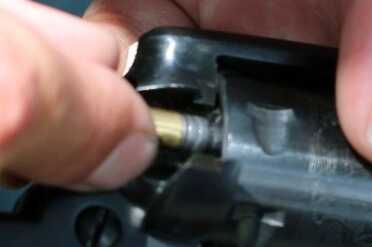
These precious rimfire rounds are much smaller than .45 Colt, and harder to load for those of us with bigger fingers.
This is a 6 shot single-action revolver. You load each cartridge one at a time into the cylinder, through a loading gate. And you eject them one at a time, too. It takes a bit to load and unload. And rimfire rounds aren’t as easy to load as .44 Magnums, or .45 Colts. They’re small, and the holes they go in are small. After taking some time to load up 6 rounds (and pick up the ones you drop), you tend to take your time shooting. You make your shots count. And this is .22 LR we’re talking about, which is still about as hard to find as…
Specs
The Ruger Bearcat is a small revolver. It weighs 24 ounces and is right at 9 inches long, though it feels much smaller in the hand. It comes with a barrel that is just over 4 inches. The sights are fixed. It is kind of like a mini Ruger Vaquero. Well, the Bearcat came first—so maybe the Vaquero is a big Bearcat. Either way, this is simplicity at its finest. The review model is blued steel with the traditional Ruger rosewood grips. It is a nice looking revolver. Ruger makes a stainless version as well.
Leather and Blued Steel
There’s nothing even remotely tacticool about the Bearcat, but it is right at home on the farm. This would make a great little barn gun for pesky critters in the feed room. When I picture a blued steel revolver, I usually think of a nice leather holster to go along with it. I had Leather Creek Holsters send me one of their Bearcat holsters. This is a very nice well made piece of leather. The hand-stamped basket-weave of the Leather Creek, especially in this deep red, accentuates the grips on the Bearcat. It fit the Bearcat nice and tight. The traditional hammer loop holds the revolver in tightly and I wouldn’t be afraid of it coming out while on a ride. Follow this link for a more in-depth look at Leather Creek Holsters.
The New vs. The Old
The Bearcat originally came out back in 1958. But when Ruger changed up their revolver line to use their new transfer bar safety mechanism, the Bearcat went out of production. Between 1975 and 1993 you couldn’t buy a brand-new Bearcat. In 93 Ruger reintroduced the Bearcat with the transfer bar safety. With a revolver as small as this one, Ruger must have needed time to get the design just right and to fit the extra pieces inside. It is a tight fit. But you can carry the New Bearcat with all 6 chambers loaded instead of 5 like on the old model.
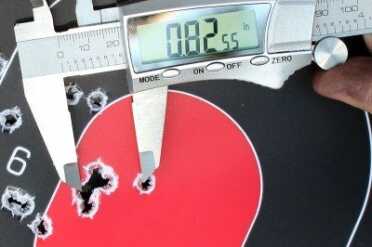
This six shot group was made from seven yards. Without that random flier, it would be better. It isn’t terrible, but it was the best we could get from the Bearcat.
At the Range
I shot the Bearcat on a number of different trips to the range. I used whatever 22 LR ammo I had (or could get my hands on). Some were fancy Federal match-grade rounds and some were 10-year-old CCIs I found in the bottom of a long forgotten range bag. One of the great things about a revolver is that it doesn’t care what type of ammo you shoot out of it. This was true for the Bearcat. Everything functioned, as it should, every time. This is a really fun little revolver. The recoil is extremely mild and would be great for teaching a first time shooter.
As fun as it is to shoot, I like to hit what I’m aiming at. Ruger makes some tack drivers. I’ve shot 10/22s, and 22/45s, and Mark IIIs that are dead on. Ruger understands how much it means to shooters, and even function test all of their guns before they leave the factory-and part of that function testing includes some basic accuracy evaluations. It is a lot more than most companies do. Yet this one needs some help.
The groups we shot with the Bearcat were not great. It didn’t matter what type of ammo we used. They were pretty wide. This revolver should be able to do much better. From 7 yards they were about .8 inches and opened up to over two inches around from 25 yards. You could look to the platform itself—rimfire revolvers aren’t, on the whole, as accurate as rimfire pistols. The sights on the Bearcat aren’t meant for surgical work. But there’s a bigger problem, and I am pretty sure I know what it is.
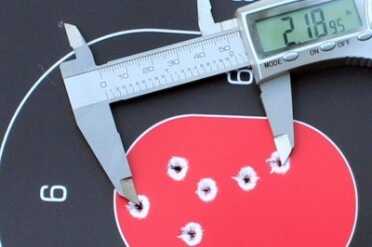
At 25 yards, the groups were much wider. That is better than 8 MOA for those of you keeping scope at home. The problem is the trigger, for sure.
The Trigger
I am a big fan of Ruger revolvers and have shot a bunch of them over the years. Like some of my daughter’s potential boyfriends, this Bearcat trigger has some grit, some mush, and a touch of creep. It was also inconsistent. Sometimes it broke around 7 pounds, other times it was closer to 8. It even dropped to 6 pounds a few times. I have shot other Bearcats, new and old models, and none of them had a trigger that felt like this. If this were my personal gun, I would send it back to Ruger for repair. Ruger has great customer service and I have no doubt they would make this right.
And this is testament to a question we at GunsAmerica get from time-to-time. No, Ruger doesn’t cherry-pick the best guns to send to their reviewers. They pull one from the production models and send it on. Occasionally, though very rarely (especially with Ruger), a gun may have an issue that needs more attention.
The trigger isn’t enough to keep me from enjoying the gun. Yet there are some things that I’d like to do with a gun like this that I won’t, at least not until I get the trigger smoothed out. Think about the potential as a teaching tool. If I’ve learned anything about teaching kids, it is that you don’t buy the cheap-ass crap that they market to kids. Go for the best. Make the experience rewarding, and they’ll come back. The Bearcat is the ideal gun to introduce kids to handguns, or it can be. This one will be, after a little work.
Final Thoughts
If this Bearcat had a better trigger it would be a winner. Even with the bad pull, I did have fun with it. A better trigger would improve the accuracy. With such a small, light revolver, it can be a challenge to keep the gun on target. When the weight was coupled with the pull weight fluctuations, I found it almost impossible to know when the trigger was going to break.
Still, the Bearcat really is a nice little revolver. This quality is reflected in the price. The New Bearcat has an MSRP of $569. That puts this gun in line with a lot of the full-sized single action revolvers on the market (at least the imports). If it were a novelty, or just intended to be a fun-gun, it would have to come in at a much lower price point. But this revolver has higher aspirations. It is a fun range plinker that could also be a useful tool on the farm. I enjoyed the nostalgia of shooting some tin cans. Maybe that is the problem with the groups. The Bearcat doesn’t want to be a range queen. It wants to blast tin cans and protect the corn crib from rats, and it wants to be a quality teaching tool that will out-live you, but not the legacy you instill in your kids and grand-kids. The Bearcat is certainly up for that.
[one_half]
[/one_half][one_half_last]
[/one_half_last]
[one_half]
[/one_half][one_half_last]
[/one_half_last]
[one_half]
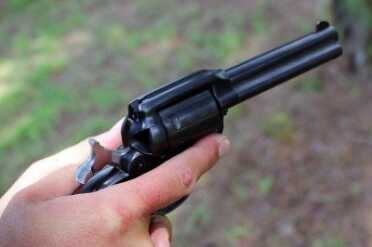
Though the gun is smaller than your typical single action cowboy gun, it is still larger enough to control.
[/one_half][one_half_last]
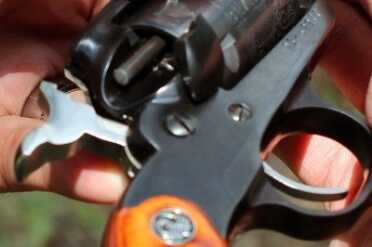
The plunger kicks out shells. You won’t ever have to fish out one that gets stuck because the plunger isn’t long enough.
[/one_half_last]
[one_half]
[/one_half][one_half_last]
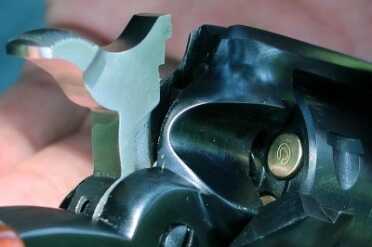
The easiest way to check if the gun is loaded is to spot check through the gate, though brass is visible from the side, too.
[/one_half_last]
[one_half]
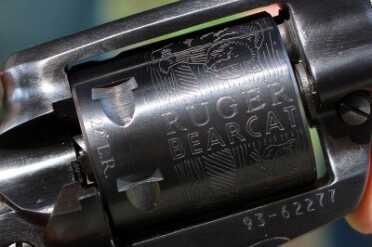
What is a Bearcat exactly? All roads point back to the binturung, which is either a cat-like thing that’s the size of a bear, or a bear-like thing that’s closer to the size of a cat (depending on how you look at it). Fitting.
[/one_half][one_half_last]
[/one_half_last]
[one_half]
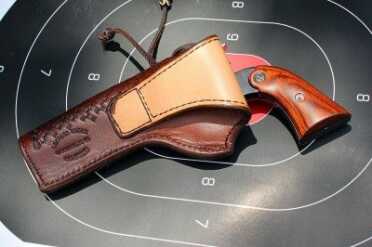
Overall, the Leather Creek holster is well made and handsome. It is a serious addition to a Ruger Bearcat, and one that allows the rimfire revolver to realize more of its practical potential.
[/one_half][one_half_last]
[/one_half_last]

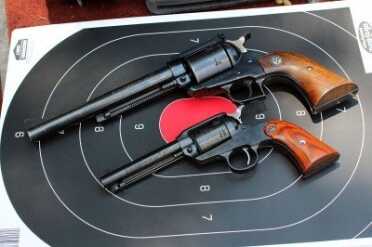
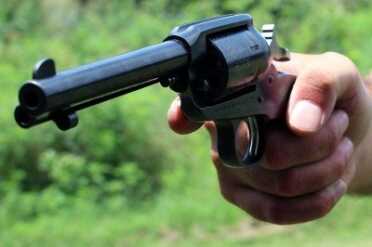

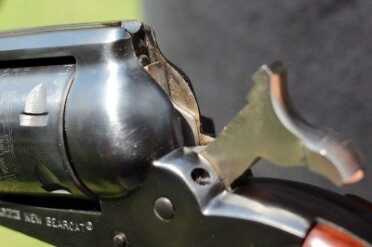
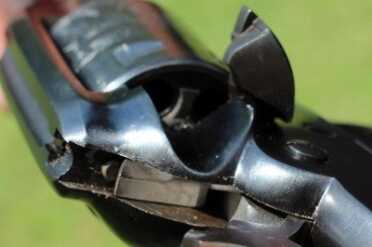
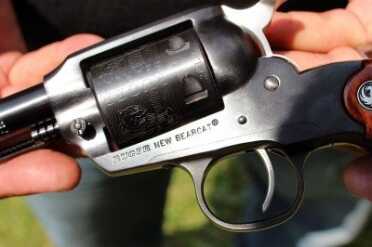
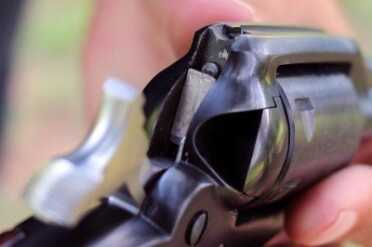
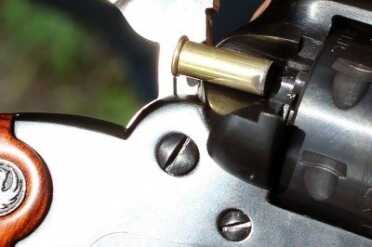
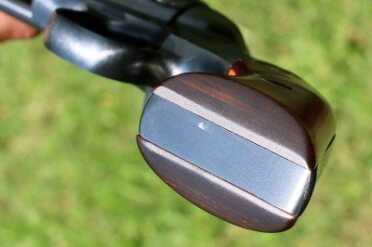
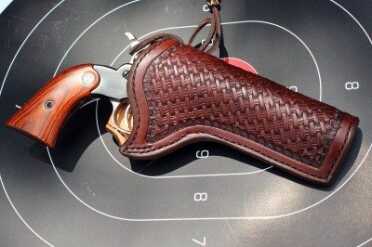
I have an all steel Bearcat. I can’t honestly recall what type of trigger it has; I quickly grew tired of the poor grouping ability, and it has become a gunsafe queen. Maybe as the previous commenter said, I just need to run a lot more ammo through it before I give up on it. But at the moment I find it a very likable gun – until I shoot it.
One thing I did that helped a bit: I cut a tiny, flat 45 degree bevel on the rear part of the front sight, using a dremel, and re-blued using Oxpho blue. Enough so that the top of the bevel meets the highest part of the sight. The problem was that with the original rounded rear corner, the light would reflect off the curve giving me a bad sight picture. The small bevel took care of that at least – from the rear all you see at the top of the front sight is the non-reflecting flat bevel.
I see a lot of articles and reviews on .22s and my reaction is why?
I’m still shooting ammo I bought in the early 90s. Except for the high priced stuff on line, .22 ammo is harder to come by than a good day for an old man with a broke back.
As the largest and most prolific of the American firearms manufacturers and one that sells one of the highest if not the highest percentage of .22s compared with other manufacturers, Ruger ought to consider investing in a new ammunition production facility just for .22 ammunition. Sales of .22 guns would increase if ammo were available.
Big expense? Yes. Big effort? Yes. Big payback? Yes. Low risk? I’d say so. If you can’t sell .22 ammo in todays market and in the years to come, you need to fire your staff and hire new ones.
My 1st pistol was bought for my 21st birthday with my hard earned money, and I really wanted a Bearcat, but none were available for order anywhere – My mom was a gun dealer. I was in a hurry, so I went to my best gun dealer and bought a single six from him. I loved that gun until I found out it had aluminum trigger and hand guard. Then Bill Ruger basically copped out to the gun grabbers with his self imposed kiss butt magazine ban! I sold that pistol for a loss just because I couldn’t stand to look at it anymore. I’m am now a Ruger fan again!
I went with the American made Heritage Rough Rider .22 revolver for $189 new. They make them in Florida and it has a 6 1/2″ barrel. They look very similar and I appreciate the savings. I really like it!
I bought my daughter a Stainless steel Ruger Bearcat,and it just fits her small hand right.Extra fun can killer,everybody that shoots it really likes the way it handles.
Not much of a Bearcat history without even a mention of the 64,417 all-steel Super Bearcats manufactured 1971-74.
RE Chuck’s comment: As I think you basically said, I imagine that Ruger decided to use the conversion design for production New Bearcats because they also planned to offer the conversion to owners of original Bearcats. Not sure why they didn’t do the same with the Single-Six. Perhaps the decision to offer the conversion came after the production gun was designed?
If you really want an old model Bearcat, you should be able to find one without too much trouble. I often see them at gun shows for about the same price as – maybe even lower than – the new guns.
I finally broke down and bought one, but I wanter the old model with the brass colored trigger group. It turned out that I found one made in 1967 the year I finished high school just the perfect match. I choose not to have it modified by Ruger with the safety system offered for free I love the four clicks of the hammer being pulled back. When loaded I only load five cylinders for safety sakes, I just wish Ruger had stuck with the brass trigger it just makes for a more apealing little gun. What I paid for the one I have I could have had a new one. I mainly use it to shoot lizards off my front porch useing shotshells, never missed any.
While I’d like the size of the Bearcat when compared to the SingleSix just because the trigger needs attention it would be a No purchase. Its hard enough with a short gun to be accurate and I would not handicap my children by giving them a pistol with accuracy issues due to a crappy trigger. Sorry but if Ruger whats my money they have to come across with the total package.
Elmer Keith would roll over in his grave if he were to hear “short barreled pistols can’t be accurate.”
I have my Dad’s from about 1963, cost about $40 new at the time. One of my favorites for sure. The cylinder has a bear and a cat engraved into it. I could buy another easily.
It is not surprising your test Bearcat has a poor trigger. Ruger has designed three different triggers for the single-action line. Their original trigger design, used in the “old model” guns, did not have the transfer bar safety. A half-cock position of the hammer allows the cylinder to turn for loading. The second Ruger trigger design is used in the “new model” guns. This design has the transfer bar safety and no half-cock position. Opening the loading gate allows the cylinder to turn. The third design is the “safety recall” design that converts old model guns to the transfer bar design. These guns are easily identified by having a transfer bar and using a half-cock hammer position to allow cylinder rotation. The hybrid “safety recall” trigger system is the most likely to be poor, and is the most difficult to improve. Most gunsmiths will recommend replacing the original parts in an old model gun, if you want a better trigger pull. Unfortunately, the “new model” Bearcat does not have the new model trigger, but uses the hybrid design instead. Ruger must have decided to use the conversion design for production guns, rather than go through the expense of downsizing their new model design for the low production Bearcat.
I just looked at a Bearcat and an old Single Six in a store the other day. The trigger on the Bearcat was second rate, like the one you just reviewed. The trigger on the Single Six was beautiful … it came home with us.
The bearcat is literally a bear and a cat. The new model is not scrolled as nicely as the originals as far as what is shown, but still from the picture depicted here it is clearly still two separate animals.
I have the Lipsey’s 3″ shopkeeper model. This gun seemed to be in keeping with the author’s observation regarding trigger inconsistency. However, what I found in this gun, unlike all the other sixguns and pistols I’ve purchased and shot from brand new, is that it took a few hundred rounds for this rascal to settle down. I was discouraged and disappointed after my first couple of range sessions, but as the gun broke in, it became more consistent in every respect. Now, with regularity, I hit 12 ga hulls off-hand/single handedly at 20 feet-perfect for rodent patrol or camp use. Perhaps it still won’t meet grouping standards to quantify it as excellent, but in my experience, I feel the little gun does (eventually) live up to the standard the author believes it has the potential to achieve.